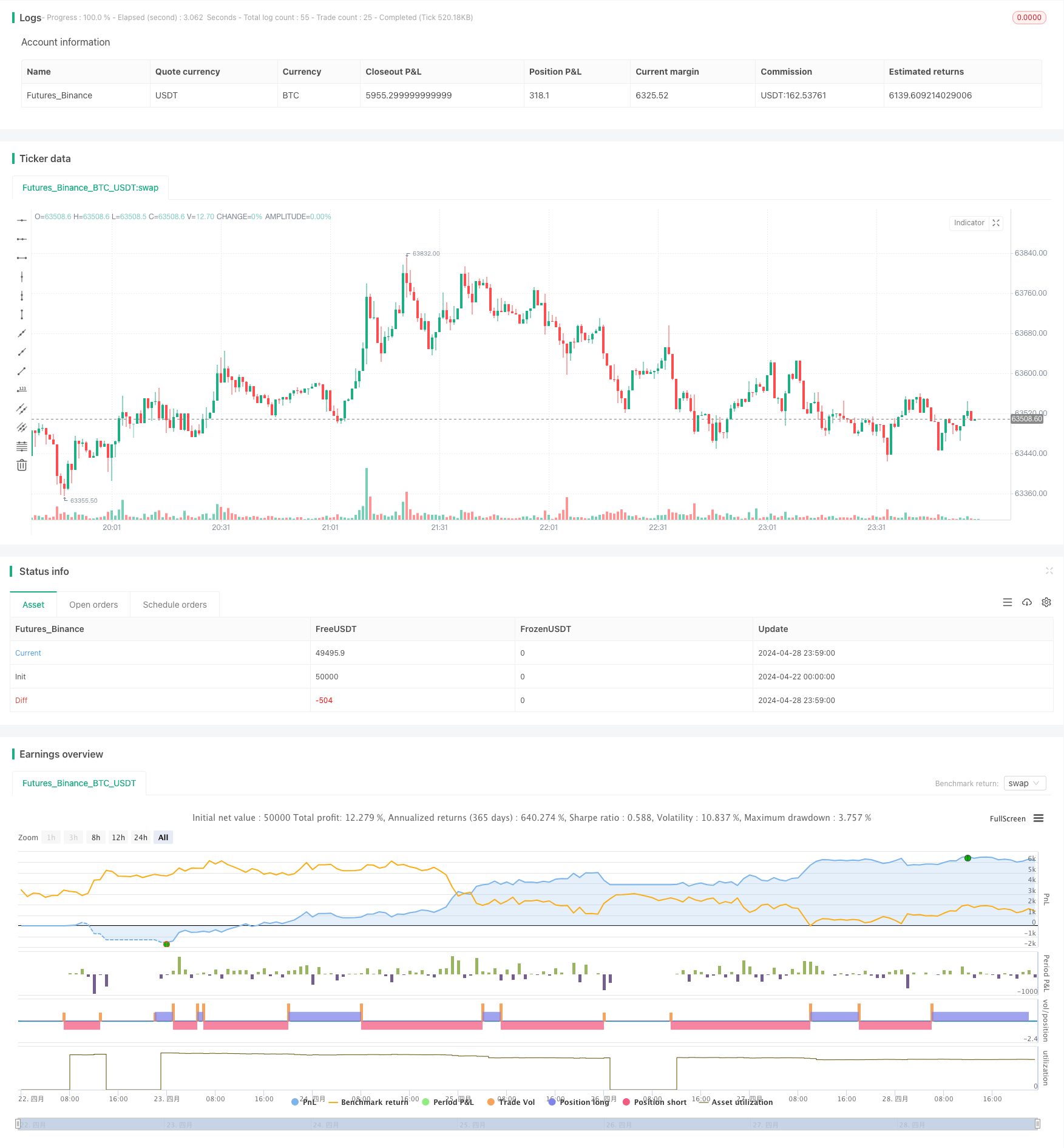
概述
该策略结合随机震荡指标(Stochastic Oscillator)和移动平均线(Moving Average)来判断市场的超买和超卖状态,并根据移动平均线的趋势方向来确定交易方向。当随机震荡指标在超卖区交叉向上,且移动平均线呈上升趋势时,策略开多头仓位;当随机震荡指标在超买区交叉向下,且移动平均线呈下降趋势时,策略开空头仓位。同时,策略设置了止损(Stop Loss)来控制风险。
策略原理
- 计算随机震荡指标的 K 值和 D 值,其中 K 值是价格相对于最高价和最低价的位置,D 值是 K 值的移动平均线。
- 计算指定周期的移动平均线。
- 判断进场条件:当 K 值从下向上穿越超卖水平,且移动平均线向上时,开多头仓位;当 K 值从上向下穿越超买水平,且移动平均线向下时,开空头仓位。
- 判断出场条件:当 K 值与移动平均线交叉,且移动平均线改变方向时,平仓。
- 设置止损,控制风险。
优势分析
- 结合随机震荡指标和移动平均线,能够较好地捕捉市场趋势和超买超卖状态。
- 使用移动平均线的趋势方向来过滤交易信号,提高交易质量。
- 设置止损,有效控制风险。
- 代码结构清晰,易于理解和修改。
风险分析
- 随机震荡指标和移动平均线都是滞后指标,可能出现信号延迟的情况。
- 在震荡市场中,该策略可能会出现频繁交易,导致高交易成本。
- 固定的止损比例可能无法适应不同的市场环境,需要根据市场波动性进行调整。
优化方向
- 可以考虑引入其他技术指标,如 MACD、RSI 等,以提高信号的可靠性。
- 对于止损,可以采用动态止损或者基于 ATR(Average True Range)的止损方法,以更好地适应市场变化。
- 可以根据市场趋势和波动性,动态调整随机震荡指标和移动平均线的参数,以优化策略表现。
- 引入仓位管理,根据市场状况和账户风险,动态调整仓位大小。
总结
该策略通过结合随机震荡指标和移动平均线,在捕捉市场超买超卖状态的同时,利用移动平均线的趋势方向来过滤交易信号,并设置止损来控制风险。策略思路清晰,易于理解和实现。但是,策略也存在一些局限性,如指标滞后、频繁交易等问题。通过引入其他技术指标、优化止损方法、动态调整参数和仓位管理等方式,可以进一步提升策略的表现和稳健性。
策略源码
/*backtest
start: 2024-04-22 00:00:00
end: 2024-04-29 00:00:00
period: 1m
basePeriod: 1m
exchanges: [{"eid":"Futures_Binance","currency":"BTC_USDT"}]
*/
// This Pine Script™ code is subject to the terms of the Mozilla Public License 2.0 at https://mozilla.org/MPL/2.0/
// © Pablo_2uc
//@version=5
strategy("Estrategia Stoch + MA c/ SL", overlay=true)
// Parámetros del Estocástico
length = input.int(14, title="Longitud Estocástico")
smoothK = input.int(3, title="Suavizado K")
smoothD = input.int(3, title="Suavizado D")
oversold = input.int(20, title="Sobreventa")
overbought = input.int(80, title="Sobrecompra")
// Parámetros de la Media Móvil
maLength = input.int(9, title="Longitud MA")
maSource = input(close, title="Fuente MA")
// Capital inicial
capital = 500
// Tamaño de posición (10% del capital)
positionSize = 1
// Stop Loss (2% del precio de entrada)
stopLossPercent = input.int(2, title="Stop Loss (%)") / 100
// Cálculo del Estocástico
k = ta.sma(ta.stoch(close, high, low, length), smoothK)
d = ta.sma(k, smoothD)
// Cálculo de la Media Móvil
ma = ta.sma(maSource, maLength)
// Condiciones de entrada en largo y corto
longCondition = ta.crossunder(k, oversold) and ma > ma[1]
shortCondition = ta.crossover(k, overbought) and ma < ma[1]
// Condiciones de salida
exitLongCondition = ta.crossover(k, ma) and ma < ma[1]
exitShortCondition = ta.crossunder(k, ma) and ma > ma[1]
// Estrategia
if (longCondition)
strategy.entry("Long", strategy.long, qty=positionSize)
strategy.exit("Exit Long", "Long", stop=close * (1 - stopLossPercent))
if (shortCondition)
strategy.entry("Short", strategy.short, qty=positionSize)
strategy.exit("Exit Short", "Short", stop=close * (1 + stopLossPercent))
// Cierre de posiciones
if (exitLongCondition)
strategy.close("Long")
if (exitShortCondition)
strategy.close("Short")
相关推荐